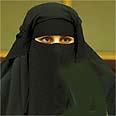
Israel’s Jewish population decreasing
Central Bureau of Statistics data show that since 2000 Jewish population decreased by 1.8 percent, while Muslim population increased by 1.1 percent during past five years by 1.1 to 1,140,600; majority of population (82 percent) satisfied with their lives
According to Central Bureau of Statistics data published on Tuesday, the population of the State of Israel at the end of 2005 was comprised of 6,990,700 people, of which 5,313,800 were Jewish (76 percent of the entire population), and 1,377,100 were Arab (19.7 percent) according to data published by the Central Bureau of Statistics.
The data also showed that since 2000, the Jewish population has decreased by 1.8 percent, while the Muslim population has increased during the past five years by 1.1 to 1,140,600.
According to the report, the 8800 people evacuated from Gaza settlements and northern Samaria as part of the August 2005 disengagement relocated mostly to the south (65 percent), but also to the north (11.5 percent), the West Bank (9.1 percent), and to the country's central area (8.4 percent).
The Israeli population is considered relatively young. Children aged 0-14 make up 28 percent of the population, compared to 17 percent in other western countries. On the other hand, Israel’s older population bridges the gap, with adults aged 65 and above comprising 10 percent of the population, compared to 15 percent in other western countries.
In comparing between religions, the Jewish population in Israel is the ‘oldest’, and the Muslim population is the ‘youngest’. Adults aged 65 and over make up 11.8 percent of the Jewish population, compared to 2.8 percent of the Muslim population.
Conversely, children aged 0-14 comprise 42.6 percent of the Muslim population in Israel, compared to 25.6 percent of the Jewish population. The average age in the Jewish population in Israel stands at 30.6, while it stands at a much lower number of 18.6 for Muslims.
The birth rate in Israel has decreased over the past two years by about 4 percent, from 2.95 in 2003, to 2.84 in 2005.
Most Israelis satisfied with their lives
Life expectancy in Israel has risen to 78.3 years for men, and 82.38 years for woman. Likewise, there has been an increase in the gap between the life expectancy age of the Jewish population and the Muslim population.
In 2005, 21,000 people made aliyah. Of those, 9,400 were from the former Soviet Union, and account for 44 percent of new immigrants, where as 3,600 were from Ethiopia, accounting for about 17 percent of olim.
Jewish households make up 84 percent of the population in Israel, while Arab households make up 13 percent.
In 2002/03, 97 percent of Arab schools offered Hebrew classes, while only 9 percent of Jewish schools offered Arabic classes.
Of 36,000 applicants for a Bachelors degree, 58 percent were accepted, and of 18,000 applicants for a Masters degree, 63 percent were accepted.
The majority of the population (82 percent), are satisfied with their lives (the younger and more religious more so than the older and more secular). The same percentage of people is satisfied with their jobs but only half of them are satisfied with their salaries.
It should be noted that the data does not include kibbutz populations, institutional populations, student dorms and southern Bedouin populations.
The dead Sea level continues to decrease at a rate of about one meter a year. In December 2005 it stood at 418.53 meters.










